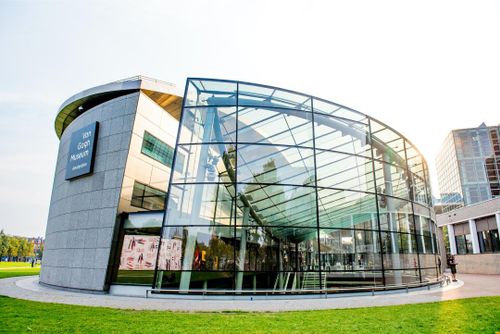
Spend a morning at the Van Gogh Museum in Amsterdam
Admire the Dutch master's famous paintings and drawings as well as art by his contemporaries and friends at Amsterdam's world-famous Van Gogh Museum. The museum houses the largest permanent collection of Vincent Van Gogh's works with over 200 paintings on display. You can easily spend 2-3 hours browsing the artworks. And before you leave, don't forget to pick up some exclusive souvenirs at the museum shop.
Best Time to Visit
The Van Gogh Museum is one of Amsterdam's most popular attractions. If you want to avoid long queues, go early in the morning (before 11 a.m.) or late afternoon (after 3 p.m.). Avoid peak times like the weekends. Also, the museum can get crowded when it rains because everyone's looking to head indoors. 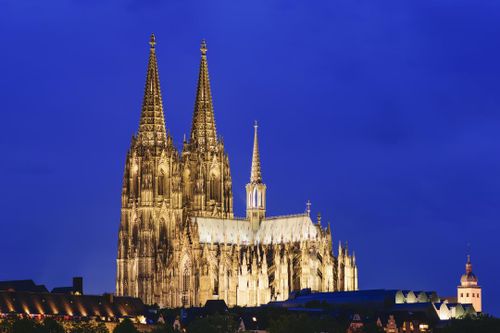
Marvel at the Cologne Cathedral
The awe-inspiring Cologne Cathedral is a prime example of magnificent Gothic architecture. With a humongous 8,000 square meters of floor space and the capacity to hold 20,000 people, it is an impressive building that dates back to 1248. On the outside, its two massive towers soar to 157 meters. Inside, the spectacular stained-glass windows are considered some of the best in the world.
You Should Know
You can climb to the cathedral's roof for breathtaking views of Cologne. However, there is no lift and you'll have to climb more than 500 steps if you want a bird's eye view of the city. 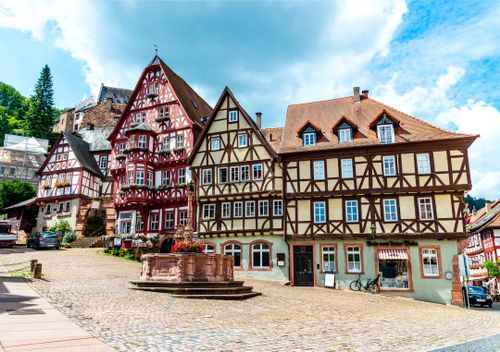
Explore Charming Miltenberg
Miltenberg is a picturesque medieval village on the Main River (pronounced mine). The historic market square, lined with timber buildings, has a unique atmosphere and charm. And high above the city is Mildenburg, an imposing castle dating back to the 12th century, now home to ancient and contemporary artworks in the on-site museum. Miltenberg has one of the longest and prettiest main streets in all of
Germany, so keep those camera batteries charged to capture this picture postcard town.
Best Time to Visit
The summer months (June to August) have pleasant temperatures and little to no rain with average highs in mid-70s. Perfect for wandering around this stunning medieval town.
Make a Date with History in Nuremberg
Due to its strategic location, Nuremberg has been an important commercial hub since the middle ages. The rich heritage of the second largest city in Bavaria is evident from the historical wonders that dot the Old Town. A museum dedicated to the Nazi-era is a powerful and sobering reminder of the country's history. Another claim to fame is that two German delicacies, gingerbread and Bratwurst (sausages), originated in Nuremberg, so don't forget to sample them.
You Should Know
The Nuremberg Furth Card gives you free admission to more than 50 museums and attractions as well as free use of public transport. 
Tour Wachau Valley Wineries
For a great day out, take the train from Vienna to Melk. Start by exploring the Benedictine Melk abbey, one of Europe's greatest sights. Then, wander the side streets of the Old Town for a glimpse of the town's rich cultural heritage. Ride bicycles from Melk to Krems, a distance of about 24 miles, admiring the pretty river valley and stopping at wineries along the way to sample local wines.
You Should Know
The Melk Abbey hosts some of the world's finest performances, festivals, and carnivals, especially in the spring and summer seasons. Check online to see if there's something going on when you're there.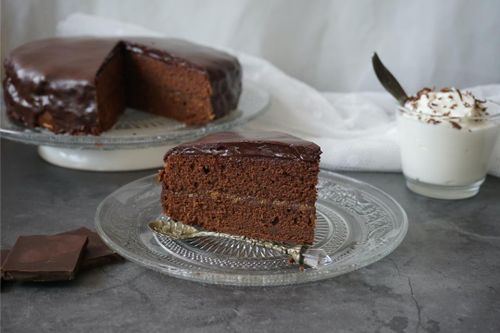
Eat Sachertorte in Vienna
Now one of Vienna's most celebrated confections, Sachertorte was conceived in the 19th century by Franz Sacher for Prince von Metternich. This dreamy rich chocolate cake with a slither of apricot jam in the center is decorated with a glossy mirror glaze. No visit to Vienna is complete without enjoying this sweet indulgence.
You Should Know
Wondering where to get the best Sachertorte in the city? We don't want to start a cake war, so suffice it to say there are several cafes in the center of Vienna (in the Innere Stadt or 1st municipal district) where you can enjoy traditional Sachertorte in an elegant atmosphere.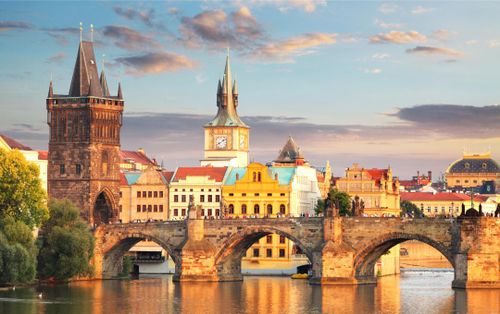
Enjoy a Romantic Stroll on the Charles Bridge in Prague
Dating back to medieval times, the Charles Bridge is arguably one of Europe's most beautiful. The historic bridge is the oldest one across the Vltava River and forms a part of the Royal Way, the traditional route taken by Czech Kings on coronation day. Stroll along the 500-meter length of the bridge for impressive views of Prague, watch street performers, and perhaps pick up a souvenir from the many kiosks.
Best Time to Visit
The warm summer months see a large influx of tourists. The best times to visit Prague are the spring and fall seasons when the weather is mild and there are fewer crowds.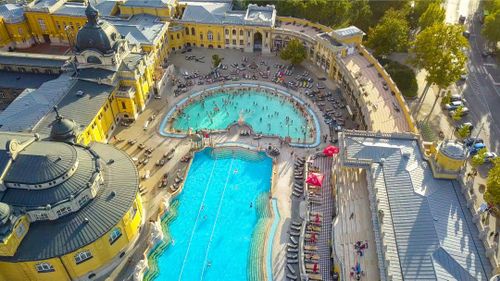
Relax at the Gellert Baths in Budapest
The city's grandest spas, the Gellert Baths in Budapest, were built in the early 20th century in Art Nouveau style. Renovated to their former glory in 2008 (after suffering extensive damage during World War II), the baths feature an open-air pool, a Finnish sauna, and an effervescent pool among others. Treat yourself to a massage or spa treatment. We recommend the harmony massage, a calming full-body treatment with warm aromatic oils.
You Should Know
The baths are open every day of the week from 6 a.m. to 8 p.m. Tickets are sold until one hour before closing. Guests are asked to leave the pools 15 minutes before closing time.
Getting There
Starting your Danube River Cruise is a smooth process, no matter where you're coming from. Geographically, the Danube flows through Central and Eastern Europe, passing through multiple countries, including Germany, Austria, and Hungary, before reaching the Black Sea. Major cruise lines often set sail from key cities such as Vienna or Budapest, both of which are easily accessible by plane from international destinations. Once you land, transfer to the port is typically arranged by the cruise operators, ensuring you get from the airport to the ship with ease. These cities are well-equipped to welcome travelers, offering modern amenities and a straightforward journey to embark on your river adventure.
The Perfect Time for a Danube River Cruise
When considering a Danube River Cruise, the ideal period stretches from May to September, marked by warm weather and extended daylight hours. This season is perfect for river cruising, offering clear skies and temperatures ranging from 20 to 30 degrees Celsius. These conditions are ideal for both sightseeing and relaxing on the deck, making your river cruising experience on the Danube both enjoyable and memorable. Keep in mind, however, that summer is the peak season for river cruising on the Danube, meaning you'll encounter the most significant number of fellow cruisers.
For a more tranquil river cruising experience, late spring or early autumn are excellent choices. Opting for a Danube River Cruise in April or October means you'll enjoy milder weather and encounter fewer crowds, which enhances the tranquility and intimacy of your river cruising journey. The cooler temperatures during these months are particularly appealing for those who prefer to avoid the intense summer sun. Additionally, river cruising during the off-season might offer the advantage of better deals. It's worth noting that winter is less ideal for a Danube River Cruise, as the weather turns chilly and many cruise services pause operations, limiting the river cruising options during this time.
Experience the Flavors of the Danube on a River Cruise
Savoring the diverse flavors of the Danube enhances the overall cruise experience immensely. In Serbia, indulge in a plate of Cevapi, a beloved local dish of grilled minced meat, or relish the rich, layered Dobos Torte in a quaint Budapest café. Each country along the river contributes its unique taste to the culinary journey.
The ship's galley often incorporates these regional delicacies into its menu, giving you a taste of the locale even when you're on board. For wine enthusiasts, a stop in the Wachau Valley is a must, where the terraced vineyards produce some of Austria's finest Rieslings and Grüner Veltliners.
Food on the Danube isn't just sustenance; it's a cultural dialogue. Each dish tells a story of the land, the history, and the people. Make sure to enjoy the lively farmer's markets in Bratislava for fresh produce and in Belgrade for an assortment of local cheeses and baked goods. These culinary adventures provide an authentic connection to the places and faces of the Danube.
Immerse Yourself in Local Culture
A Danube River Cruise is a cultural experience, bringing you face-to-face with the customs, traditions, and celebrations that make this region unique. In
Austria, you might find yourself waltzing at a Viennese ball or sipping coffee in a traditional café. Hungary will welcome you with its folklore music and dance, while in Serbia, you might stumble upon a lively Slava – a family festivity honoring patron saints.
Each country along the Danube has its own set of festivals, like the Budapest Spring Festival or the Belgrade Boat Carnival. Engaging with these local customs is a chance to see the Danube's cultures in action. Be sure to check the calendar when you book your cruise – timing your trip with these events can be the highlight of your journey, offering a deeper connection with the places you're visiting.
Why Book a River Cruise on the Danube?
Booking a river cruise on the Danube is the ultimate travel shortcut that gives you a mix of convenience, value, and exclusive perspectives. Imagine unpacking once and waking up to a new view every day, all while enjoying the comfort of your floating hotel. You're treated to coastal scenes that road-trippers miss, and the ease of travel is unmatched—no hopping between hotels or navigating foreign train schedules. Plus, there's often the chance to dock at lesser-known ports, giving you access to hidden gems away from the usual tourist tracks. Onboard, you can mingle with like-minded travelers, making the journey as memorable as the destinations themselves. So, if you're looking to explore, relax, and see the world from a fresh angle, a Danube cruise is hard to beat.
Ready to Book Your Danube River Cruise?
Booking your Danube River Cruise is your ticket to an unforgettable journey through the heart of Europe. Imagine gliding past scenic landscapes, exploring cities steeped in history, and enjoying diverse cultures—all from the comfort of your floating hotel. From the architectural splendor of Budapest to the enchanting streets of Vienna, each stop is a new adventure. Enjoy the ease of unpacking once and waking up to a new city each day. Whether you're after the rich history, the stunning scenery, or the delightful cuisines, the Danube offers it all. Don't wait to turn this dream into reality. Look for the best deals, choose your favorite route, and get ready for the experience of a lifetime. The Danube is waiting to charm you with its endless treasures. Book your cruise today and set sail on a European adventure that you will cherish forever.















 1. Free Quote
1. Free Quote 2. Dedicated Travel Consultant
2. Dedicated Travel Consultant 3. Lowest Price Guaranteed
3. Lowest Price Guaranteed 4. Stress Free Travel
4. Stress Free Travel

